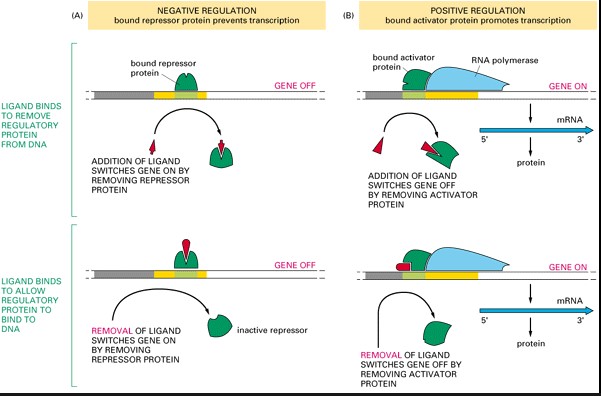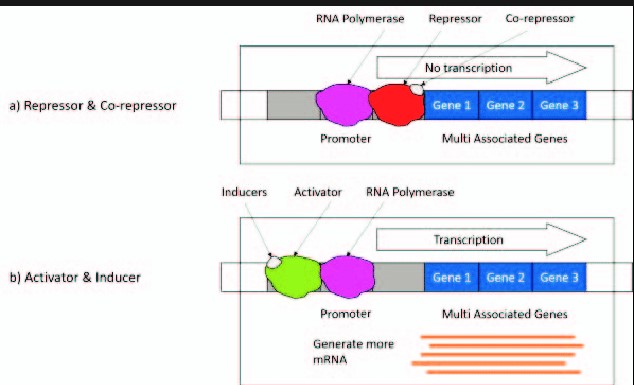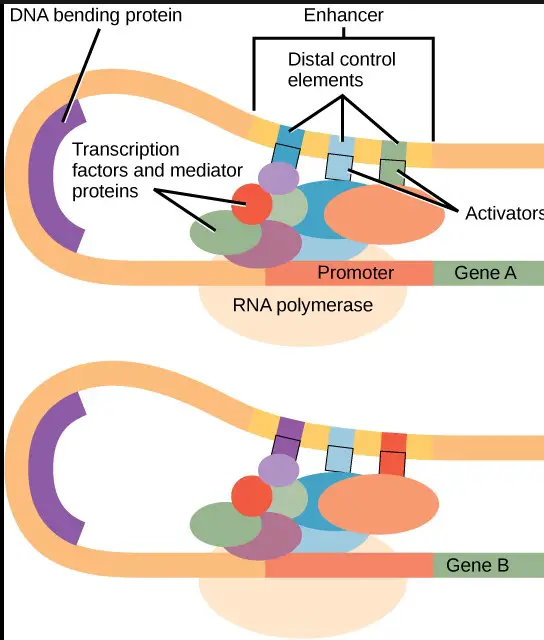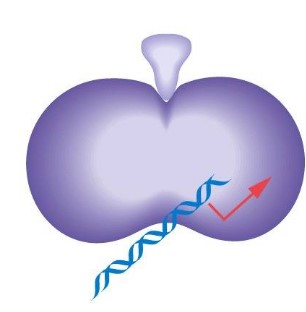Proteins, the workhorses of the cell, carry out a myriad of functions vital for survival and homeostasis. Among their roles, regulation of gene expression stands out as a key factor in cellular function and organismal development. Regulatory and repressor proteins, in particular, play critical roles in this process, acting as the on-and-off switches for genes, thereby controlling the flow of genetic information from DNA to RNA to protein.
Regulatory proteins activate gene expression, ensuring that genes are expressed at the right time and place, and in the appropriate amount. Repressor proteins, on the other hand, block gene expression, preventing the production of certain proteins. This dynamic balance between activation and repression is essential for the proper functioning of cells and the overall health of an organism.
Understanding the differences between regulatory and repressor proteins is crucial for grasping how cells control their internal environment and respond to external stimuli. These proteins not only dictate the pace of cellular processes but also have profound implications in health, disease, and biotechnology, influencing everything from developmental biology to the design of new therapeutic approaches.

Protein Basics
Types of Proteins
Proteins, the building blocks of life, are essential components of all living organisms. They serve a multitude of functions within cells, from providing structural support to catalyzing biochemical reactions. Based on their roles, proteins can be classified into several categories, including enzymes, hormones, transport proteins, defensive proteins (such as antibodies), and regulatory proteins.
Role in Cellular Functions
In the realm of cellular functions, proteins are indispensable. They play a key role in almost every cellular process, including cell signaling, molecular transport, and cell adhesion. For example, enzymes speed up chemical reactions within the cell, while transport proteins move molecules across cell membranes. This diversity in function allows cells to maintain homeostasis, respond to environmental changes, and execute complex processes like cell division and growth.
Diversity and Classification
The diversity of proteins is a testament to their complexity and specialization. Proteins can be classified based on their shape, solubility, functions, and complexity. For instance, globular proteins are typically water-soluble and play roles in metabolism, while fibrous proteins provide structural support. This classification helps scientists and researchers understand proteins’ roles in health and disease.
Genetic Regulation
Overview of Gene Expression
Gene expression is the process by which information from a gene is used to synthesize a functional gene product, usually a protein. This process is essential for the growth, development, and maintenance of all living organisms. It involves two main steps: transcription, where DNA is copied into messenger RNA (mRNA), and translation, where mRNA is decoded by a ribosome to build a protein.
Significance of Protein Involvement
Proteins play a critical role in regulating gene expression at various levels, including transcription, RNA splicing, translation, and post-translational modifications. Regulatory proteins, in particular, are crucial for turning genes on and off in response to internal and external cues, ensuring that proteins are produced at the right time, place, and quantity.
Regulatory Proteins
Definition and Function
Regulatory proteins are molecules that control the expression of genes. They ensure that genes are turned on or off at the appropriate times, allowing the cell to respond to its environment and maintain homeostasis. Regulatory proteins achieve this by binding to specific DNA sequences and influencing the transcription process.
Characteristics of Regulatory Proteins
Regulatory proteins are characterized by their ability to bind DNA with high specificity. They typically contain one or more DNA-binding domains that recognize specific DNA sequences near genes. This specificity allows them to target and regulate specific genes, making them key players in cell differentiation and the response to stimuli.
How They Control Gene Expression
Regulatory proteins control gene expression through several mechanisms:
- Activators enhance the binding of RNA polymerase to the gene, increasing transcription.
- Repressors block the binding of RNA polymerase, decreasing transcription.
- Co-activators and co-repressors do not bind DNA directly but influence gene expression by interacting with other regulatory proteins.
Examples and Roles
Common regulatory proteins include transcription factors like TFII-D, which is essential for initiating transcription in eukaryotes. Another example is NF-kB, which plays a key role in immune and stress responses. The impact of these proteins on cellular processes is profound, affecting everything from cell cycle progression to apoptosis.

Repressor Proteins
Definition and Function
Repressor proteins are a type of regulatory protein that inhibit the expression of one or more genes by binding to specific DNA sequences. Their primary function is to prevent the transcription of genes, acting as a brake on gene expression when certain proteins are not needed by the cell.
Nature of Repressor Proteins
The nature of repressor proteins is to bind to operator or silencer regions of DNA, blocking the attachment of RNA polymerase to the promoter region and thus preventing the transcription of the gene. They play a critical role in the cell’s ability to prevent the production of unnecessary proteins, thereby conserving resources and ensuring proper development and function.
Mechanism of Action in Gene Repression
Repressor proteins can act through several mechanisms:
- Competitive binding to DNA, directly blocking the binding site for RNA polymerase.
- Recruitment of other molecules that modify chromatin structure, making DNA less accessible to RNA polymerase.
- Interference with the assembly of the transcriptional machinery.
Examples and Roles
Key repressor proteins include lac repressor, which controls the metabolism of lactose in bacteria, and HES1, which is involved in the regulation of development in mammals. The action of repressor proteins is crucial for developmental processes, cellular response to environmental changes, and prevention of diseases such as cancer.

Comparison
Structural Differences
Comparing Protein Structures
Proteins are not just chains of amino acids; they are complex structures that fold into unique shapes, allowing them to perform specific functions. Regulatory proteins and repressor proteins differ in structure, which is key to their distinct roles. Regulatory proteins often have flexible binding sites that allow them to interact with a variety of DNA sequences. In contrast, repressor proteins usually have tighter, more specific binding sites that enable them to bind firmly to particular DNA sequences and block transcription.
Specific Domains and Motifs
The structural elements of these proteins, known as domains and motifs, are critical for their function. DNA-binding domains, such as helix-turn-helix in repressor proteins, are specifically designed to fit into the major groove of DNA. Activation domains found in regulatory proteins, enable them to recruit other components of the transcription machinery. These structural features dictate how each protein interacts with DNA and other molecules within the cell.
Functional Divergence
Contrast in Action Modes
The action modes of regulatory and repressor proteins highlight the functional divergence between these two types of proteins. Regulatory proteins can activate or enhance gene expression by helping assemble the transcription machinery at the start site of a gene. Repressor proteins, on the other hand, block or silence gene expression by preventing the transcription machinery’s assembly or by recruiting enzymes that make the DNA inaccessible.
Regulatory vs. Repression Mechanisms
The distinction between regulatory and repression mechanisms lies in their approach to controlling gene expression. Regulatory proteins often work through positive control, enhancing gene expression, whereas repressor proteins exert negative control, reducing gene expression. This balance ensures that cells can quickly adapt to changes in their environment or internal state by modulating gene expression appropriately.
Biological Impact
Influence on Cellular Pathways
The influence of regulatory and repressor proteins extends across numerous cellular pathways, from metabolic regulation to cell cycle control and stress response. For example, the presence or absence of certain nutrients can trigger regulatory proteins to activate genes involved in metabolism. Similarly, repressor proteins can halt the cell cycle in response to DNA damage, preventing the propagation of mutations.
Role in Disease and Health
The malfunction of regulatory or repressor proteins can lead to a variety of diseases. Cancer, for instance, can result from the failure of repressor proteins to silence oncogenes or from the overactivation of genes that promote cell growth by regulatory proteins. Understanding these proteins’ roles in disease and health is crucial for developing targeted therapies and diagnostic tools.
Role in Biotechnology
Genetic Engineering
Use of Proteins in Gene Editing
Regulatory and repressor proteins have found applications in gene editing and genetic engineering, revolutionizing biotechnology. By harnessing these proteins, scientists can precisely turn genes on or off, allowing for the creation of genetically modified organisms with desirable traits. This technology has wide-ranging applications, from agriculture to medicine.
Applications in Medicine and Agriculture
In medicine, genetic engineering has led to the development of gene therapies that can treat genetic disorders by correcting faulty genes. In agriculture, crops can be engineered to be more nutritious, resistant to pests and diseases, and tolerant of harsh environmental conditions. Regulatory and repressor proteins are at the heart of these advancements, providing the tools needed to manipulate gene expression.
Drug Development
Targeting Proteins for Therapy
Targeting regulatory and repressor proteins has become a promising strategy in drug development. By designing drugs that can modulate the activity of these proteins, it’s possible to correct abnormal gene expression patterns associated with diseases. For instance, drugs that inhibit repressor proteins involved in cancer cell proliferation can stop the growth of tumors.
Advancements in Pharmaceuticals
The advancements in pharmaceuticals driven by the study of these proteins are significant. Precision medicine, where treatments are tailored to the genetic makeup of an individual, relies heavily on understanding how regulatory and repressor proteins influence gene expression. New drugs that target these proteins more effectively and with fewer side effects are being developed, offering hope for treatments for a range of diseases, from cancer to genetic disorders.

Frequently Asked Questions
What are regulatory proteins?
Regulatory proteins are molecules that facilitate or enhance the expression of genes. They bind to DNA and assist in the transcription process, ensuring that genes are expressed at the right times and in the right cells. Their action is crucial for the proper functioning of genetic circuits and the maintenance of cellular health.
How do repressor proteins work?
Repressor proteins inhibit gene expression by binding to specific DNA sequences, blocking the access of RNA polymerase to the gene, and thus preventing the synthesis of mRNA. Their ability to silence genes is vital for controlling the timing and location of protein production within the cell, thereby playing a critical role in developmental processes and cellular response to environmental changes.
What is the difference between regulatory and repressor proteins?
The primary difference lies in their function. Regulatory proteins promote the expression of genes, facilitating the synthesis of necessary proteins, while repressor proteins inhibit gene expression to prevent the production of certain proteins. This contrast in function reflects their roles in the complex regulatory networks that govern cellular activities and organismal development.
Why are these proteins important in biotechnology?
Regulatory and repressor proteins are fundamental in biotechnology for their ability to control gene expression. They are used in genetic engineering and synthetic biology to create custom genetic circuits, allowing scientists to build organisms with novel traits, produce therapeutic proteins, and develop new treatments for diseases.
Conclusion
The interplay between regulatory and repressor proteins underpins the complex mechanisms of gene expression, enabling cells to adapt to their environment, execute developmental programs, and maintain homeostasis. Their study not only provides insight into the fundamental processes of life but also opens up avenues for therapeutic interventions and biotechnological innovations.
Recognizing the significance of these proteins extends beyond academic curiosity; it holds the promise for advancing our understanding of biological systems, improving disease treatment, and developing sustainable biotechnological solutions. As research continues to unveil the mysteries of gene regulation, the potential for harnessing these proteins in medicine and industry grows ever more promising.

